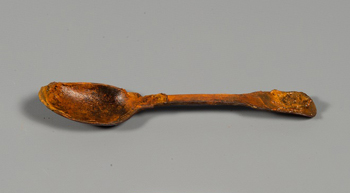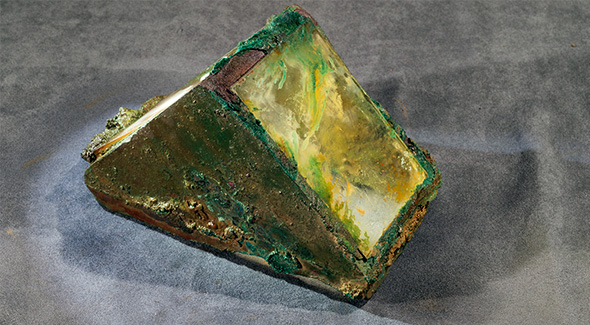
2014-2015 Artifacts
Wrecks of HMS Erebus and HMS Terror National Historic Site
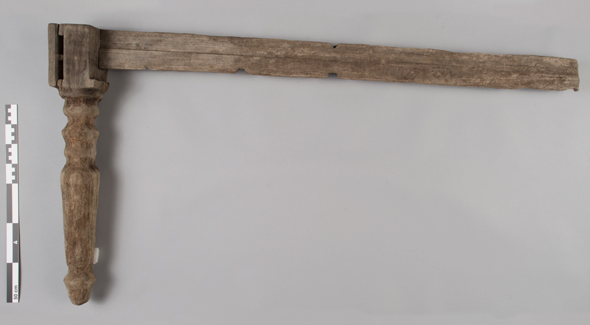
Recovered from HMS Erebus, in debris field
April 2015
Furniture leg

-
Where was this artifact found?
The archaeologists recovered a furniture leg on the seabed near the stern. Another identical piece, which has not been recovered, is located in the captain’s cabin. These two items are possibly from the same piece of furniture.
-
What material is this artifact made of?
This mahogany artifact, which is 69 cm high, 128.5 cm long and 9.5 cm wide, had to be carefully preserved and stabilized. The salt was extracted and the degraded wood was gradually filled with a consolidating agent (PEG) before the artifact was freeze-dried. This process prevented the artifact from warping or splitting. The leg has a square upper section and a rounded lower section.
-
What was this artifact used for?
This leg could have belonged to one of the pieces of furniture in the captain’s cabin.
-
What do we know about this artifact?
A contemporary artistic representation of Franklin’s cabin shows a map table at the center of the cabin. (The Illustrated London News 1845). This leg may come from a similar piece of furniture from the captain’s cabin.
Furniture leg
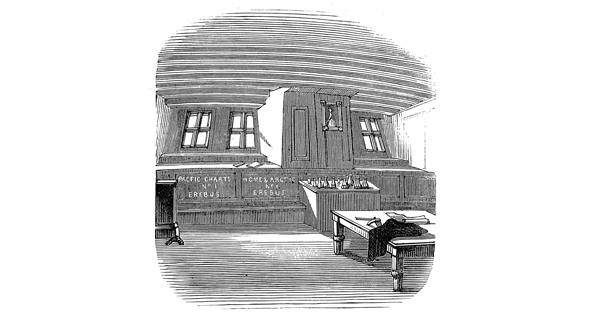
© Illustrated London News
-
Where was this artifact found?
The archaeologists recovered a furniture leg on the seabed near the stern. Another identical piece, which has not been recovered, is located in the captain’s cabin. These two items are possibly from the same piece of furniture.
-
What material is this artifact made of?
This mahogany artifact, which is 69 cm high, 128.5 cm long and 9.5 cm wide, had to be carefully preserved and stabilized. The salt was extracted and the degraded wood was gradually filled with a consolidating agent (PEG) before the artifact was freeze-dried. This process prevented the artifact from warping or splitting. The leg has a square upper section and a rounded lower section.
-
What was this artifact used for?
This leg could have belonged to one of the pieces of furniture in the captain’s cabin.
-
What do we know about this artifact?
A contemporary artistic representation of Franklin’s cabin shows a map table at the center of the cabin. (The Illustrated London News 1845). This leg may come from a similar piece of furniture from the captain’s cabin.
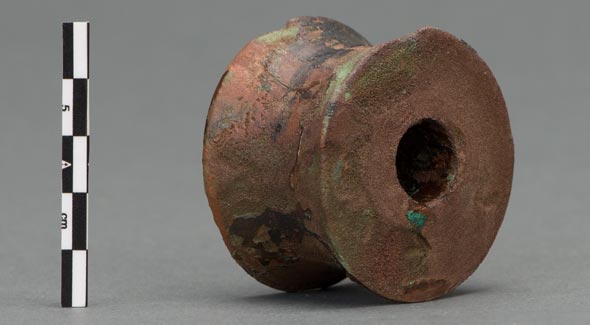
Recovered from HMS Erebus, on upper deck
April 2015
Spindle

-
Where was this artifact found?
The spindle (or roller) was on the upper deck near the starboard bulwark, towards the stern.
-
What material is this artifact made of?
The spindle is made of solid bronze.
-
What was this artifact used for?
Spindles were commonly used as guides for ropes. They also helped to prevent wear, as well as interference with other rigging components.
Spindle
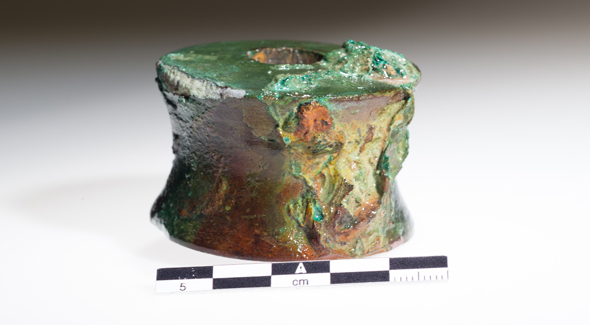
-
Where was this artifact found?
The spindle (or roller) was on the upper deck near the starboard bulwark, towards the stern.
-
What material is this artifact made of?
The spindle is made of solid bronze.
-
What was this artifact used for?
Spindles were commonly used as guides for ropes. They also helped to prevent wear, as well as interference with other rigging components.
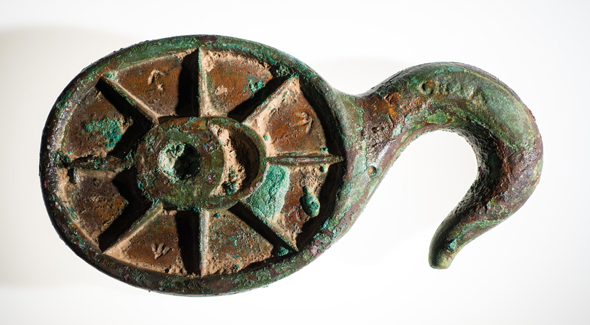
Recovered from HMS Erebus, on upper deck
April 2015
Hook block

-
Where was this artifact found?
On the seabed, on the port side of the hull towards the stern.
-
What material is this artifact made of?
The block is made of solid bronze, with an embossed ray pattern.
-
What was this artifact used for?
This block could have been used as a tackle block or for part of the ship’s standing rigging. Its regulation size in inches “6¼” is inscribed on it.
-
What do we know about this artifact?
The word “CHAIN” is stamped on the hook. This possibly indicates that it could or should be attached to a chain. It could also simply be the manufacturer’s name.
Hook block

-
Where was this artifact found?
On the seabed, on the port side of the hull towards the stern.
-
What material is this artifact made of?
The block is made of solid bronze, with an embossed ray pattern.
-
What was this artifact used for?
This block could have been used as a tackle block or for part of the ship’s standing rigging. Its regulation size in inches “6¼” is inscribed on it.
-
What do we know about this artifact?
The word “CHAIN” is stamped on the hook. This possibly indicates that it could or should be attached to a chain. It could also simply be the manufacturer’s name.

Recovered from HMS Erebus, in the debris field
April 2015
Deck illuminator

-
Where was this artifact found?
This illuminator belonged to a detached section of the upper deck, on the seabed.
-
What material is this artifact made of?
The rectangular deck prism is made of translucent glass and is 22 cm long and 7 cm wide.
-
What was this artifact used for?
The illuminator was inserted in the planks of the upper deck; it served to direct daylight onto the lower deck. Its prism shape captured as much light as possible, and it was installed flush into the deck, making it easy for sailors to walk over it.
Deck illuminator
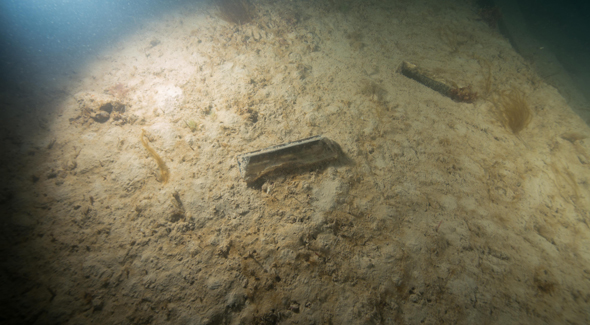
-
Where was this artifact found?
This illuminator belonged to a detached section of the upper deck, on the seabed.
-
What material is this artifact made of?
The rectangular deck prism is made of translucent glass and is 22 cm long and 7 cm wide.
-
What was this artifact used for?
The illuminator was inserted in the planks of the upper deck; it served to direct daylight onto the lower deck. Its prism shape captured as much light as possible, and it was installed flush into the deck, making it easy for sailors to walk over it.
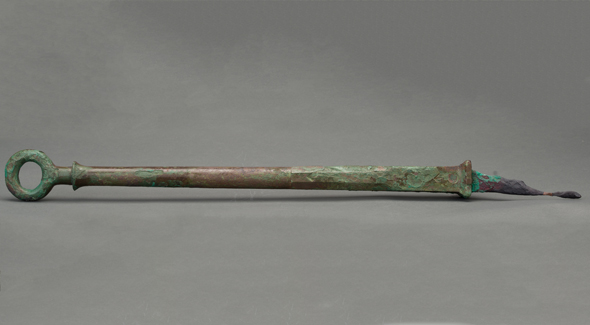
Recovered from HMS Erebus, on upper deck
September 2015
Stanchion
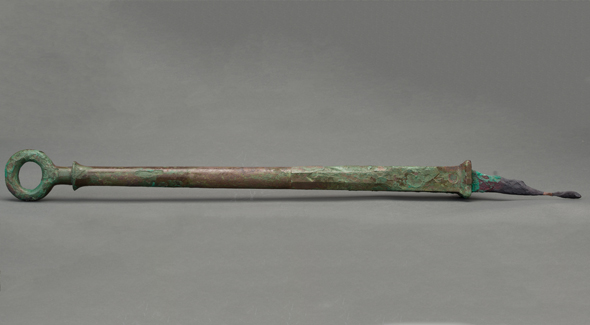
-
Where was this artifact found?
This artifact was found on the upper deck. It was detached from its original position, which was probably along a bulwark on the upper deck.
-
What material is this artifact made of?
The bronze stanchion consists of two sections welded together. There are significant signs of erosion on the end that was fastened to the deck. An eyelet is added at the top. From its base to the tip of the eyelet, the stanchion measures 51.7 cm.
-
What was this artifact used for?
These stanchions connected by rope were used as a railing or for the stowage of material. Several are illustrated on the plans of HMS Erebus and HMS Terror, and on those of other Royal Navy vessels of the period, for example, HMS Investigator.
-
What do we know about this artifact?
This stanchion appears to be too small to have been part of a railing. It would therefore have been used for the stowage of casks, spars or oars on the upper deck, as can be seen on some plans of HMS Erebus dating from 1839.
Stanchion
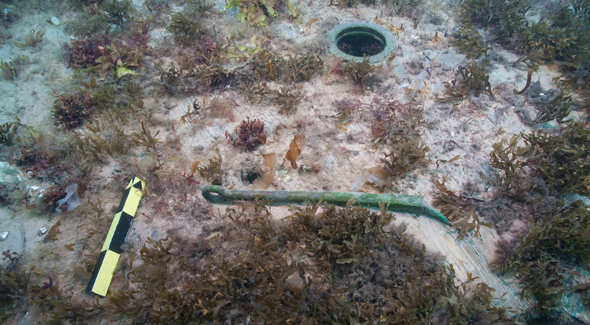
-
Where was this artifact found?
This artifact was found on the upper deck. It was detached from its original position, which was probably along a bulwark on the upper deck.
-
What material is this artifact made of?
The bronze stanchion consists of two sections welded together. There are significant signs of erosion on the end that was fastened to the deck. An eyelet is added at the top. From its base to the tip of the eyelet, the stanchion measures 51.7 cm.
-
What was this artifact used for?
These stanchions connected by rope were used as a railing or for the stowage of material. Several are illustrated on the plans of HMS Erebus and HMS Terror, and on those of other Royal Navy vessels of the period, for example, HMS Investigator.
-
What do we know about this artifact?
This stanchion appears to be too small to have been part of a railing. It would therefore have been used for the stowage of casks, spars or oars on the upper deck, as can be seen on some plans of HMS Erebus dating from 1839.
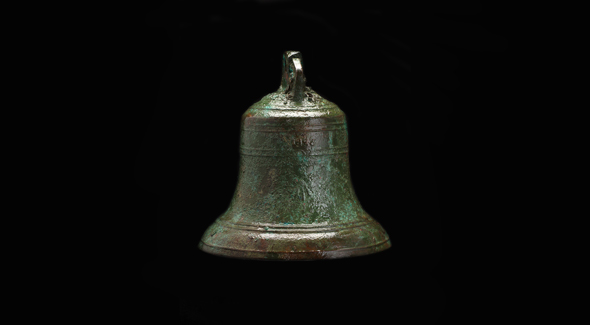
Recovered from HMS Erebus, on upper deck
September 2014
Bell

-
Where was this artifact found?
The bronze bell was found on the upper deck by the anchor windlass (winch) at the bow.
-
What material is this artifact made of?
The bell is cast in bronze.
-
What was this artifact used for?
On a ship, the bell was rung at regular intervals, day and night, and was used to mark time and determine the activities of the seamen. The bell has several ropes and two markings on its surface: the date “1845” and a large arrow called a broad arrow.
-
What do we know about this artifact?
For two years, conservators worked on the bell to preserve it. The already significantly advanced effects of corrosion, due to the bell being submerged in salt water, would have continued to progress if corrosion products had not been removed. To preserve the distinctive details that can be seen on the corroded surface, such as the date and the broad arrow, it has not been removed in its entirety. As an effect of the rust, the clapper detached, condemning the bell to eternal silence.
Bell
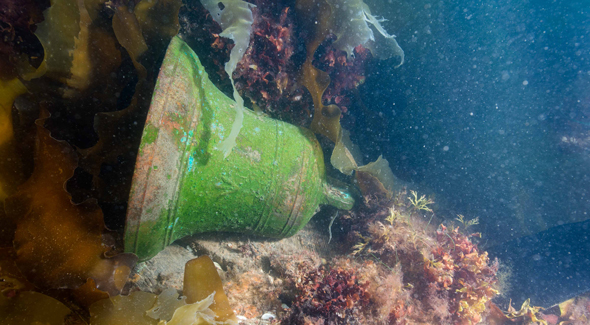
-
Where was this artifact found?
The bronze bell was found on the upper deck by the anchor windlass (winch) at the bow.
-
What material is this artifact made of?
The bell is cast in bronze.
-
What was this artifact used for?
On a ship, the bell was rung at regular intervals, day and night, and was used to mark time and determine the activities of the seamen. The bell has several ropes and two markings on its surface: the date “1845” and a large arrow called a broad arrow.
-
What do we know about this artifact?
For two years, conservators worked on the bell to preserve it. The already significantly advanced effects of corrosion, due to the bell being submerged in salt water, would have continued to progress if corrosion products had not been removed. To preserve the distinctive details that can be seen on the corroded surface, such as the date and the broad arrow, it has not been removed in its entirety. As an effect of the rust, the clapper detached, condemning the bell to eternal silence.
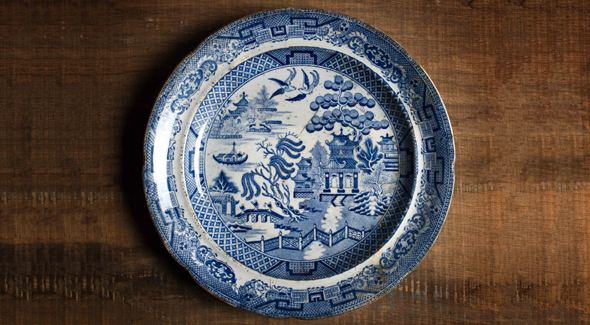
Recovered from HMS Erebus, on lower deck
September 2015
Dinner plate

-
Where was this artifact found?
The archaeologists discovered several British blue-transfer print whiteware dinner plates on the lower deck, near the galley stove, in the forecastle.
-
What material is this artifact made of?
The dinner plates are made of whiteware, a material intended to imitate Chinese porcelain. Some are decorated with a pattern known as blue willow. It was the most common and affordable pattern in the 19th century. Several pieces have engraved markings on their back or notches on their foot-ring.
-
What was this artifact used for?
These dinner plates were used daily by the ship’s crew, during meals.
-
What do we know about this artifact?
The proximity of the different plates suggests that they were stored in a cupboard not far from the ship’s galley. The fact that these dinner plates were on board the wreck is consistent with the oral Inuit history gathered in 1879 by the expedition led by Frederick Schwatka.
Dinner plate
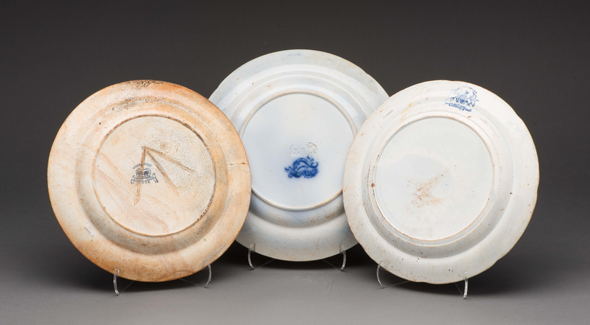
-
Where was this artifact found?
The archaeologists discovered several British blue-transfer print whiteware dinner plates on the lower deck, near the galley stove, in the forecastle.
-
What material is this artifact made of?
The dinner plates are made of whiteware, a material intended to imitate Chinese porcelain. Some are decorated with a pattern known as blue willow. It was the most common and affordable pattern in the 19th century. Several pieces have engraved markings on their back or notches on their foot-ring.
-
What was this artifact used for?
These dinner plates were used daily by the ship’s crew, during meals.
-
What do we know about this artifact?
The proximity of the different plates suggests that they were stored in a cupboard not far from the ship’s galley. The fact that these dinner plates were on board the wreck is consistent with the oral Inuit history gathered in 1879 by the expedition led by Frederick Schwatka.
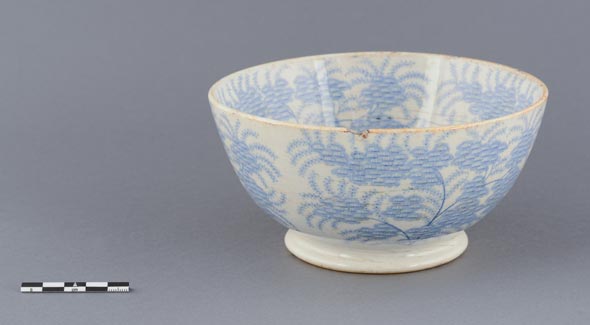
Recovered from HMS Erebus, on lower deck
September 2015
Bowl

-
Where was this artifact found?
On the lower deck, in the forecastle.
-
What material is this artifact made of?
This medium-sized bowl is made of whiteware. A flowering tree pattern with pale blue blossoms covers most of the artifact, both inside and out. The design was not printed in the centre of the inside of the bowl. On the underside, there is a blue fern pattern and the word “Forest” is inscribed.
-
What was this artifact used for?
These bowls were used daily by the ship’s crew, during meals. A large “4” is lightly engraved on the base, and there are two notches on its foot-ring, like with the other markings on the ceramic plates. These markings could be associated with a mess and/or a specific individual.
-
What do we know about this artifact?
This piece could be from Durham, in the north-east of England. Identical bowls with the inscription “JOHN ALLASON – SEAHAM POTTERY” were identified in England. J. Allason ran a pottery located in Seaham Harbour (North Sunderland) between 1839 and 1841.
Bowl
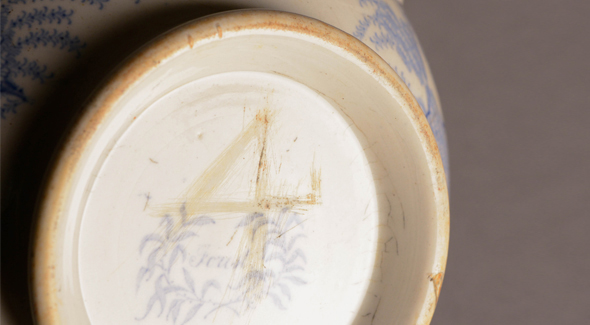
-
Where was this artifact found?
On the lower deck, in the forecastle.
-
What material is this artifact made of?
This medium-sized bowl is made of whiteware. A flowering tree pattern with pale blue blossoms covers most of the artifact, both inside and out. The design was not printed in the centre of the inside of the bowl. On the underside, there is a blue fern pattern and the word “Forest” is inscribed.
-
What was this artifact used for?
These bowls were used daily by the ship’s crew, during meals. A large “4” is lightly engraved on the base, and there are two notches on its foot-ring, like with the other markings on the ceramic plates. These markings could be associated with a mess and/or a specific individual.
-
What do we know about this artifact?
This piece could be from Durham, in the north-east of England. Identical bowls with the inscription “JOHN ALLASON – SEAHAM POTTERY” were identified in England. J. Allason ran a pottery located in Seaham Harbour (North Sunderland) between 1839 and 1841.
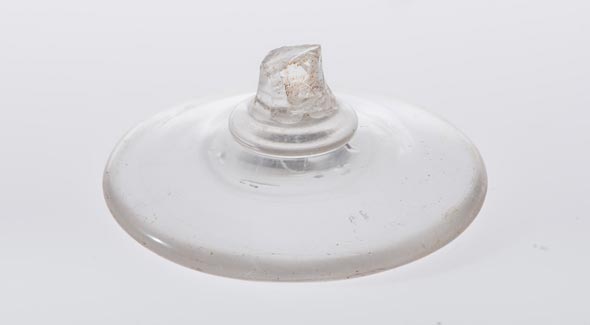
Recovered from HMS Erebus, on lower deck
September 2015
Wine glass

-
Where was this artifact found?
This foot of a wineglass came from the ship’s lower deck, on the port side in the forecastle.
-
What material is this artifact made of?
The artifact is made of colourless glass and is broken at the base of its octagonal stem.
-
What was this artifact used for?
This glass was part of the shipboard equipment. It could have been used for drinking wine, port or other liquids.
-
What do we know about this artifact?
The foot has a marking engraved on it which is either an “S” or a “2.” This marking could indicate that the artifact belonged to a crew member; normally an officer, as it was relatively costly.
Wine glass
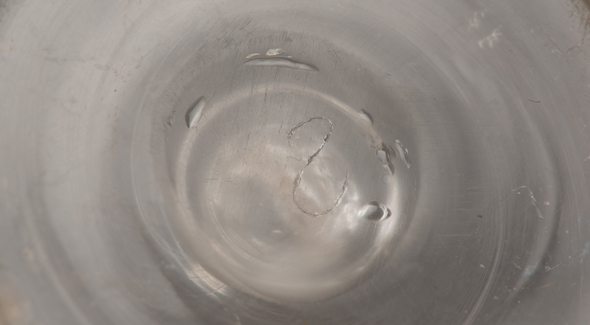
-
Where was this artifact found?
This foot of a wineglass came from the ship’s lower deck, on the port side in the forecastle.
-
What material is this artifact made of?
The artifact is made of colourless glass and is broken at the base of its octagonal stem.
-
What was this artifact used for?
This glass was part of the shipboard equipment. It could have been used for drinking wine, port or other liquids.
-
What do we know about this artifact?
The foot has a marking engraved on it which is either an “S” or a “2.” This marking could indicate that the artifact belonged to a crew member; normally an officer, as it was relatively costly.
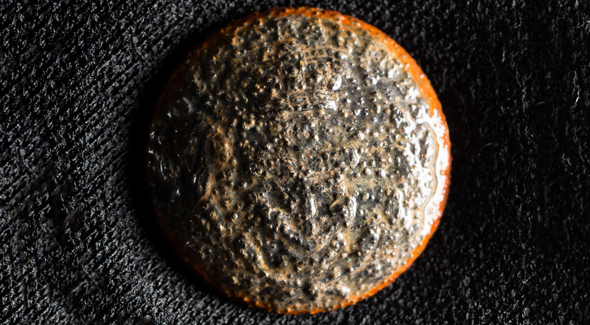
Recovered from HMS Erebus, on lower deck
April 2015
Royal Marines button

-
Where was this artifact found?
Two buttons from the uniform of a Royal Marine were discovered together on the lower deck, protected by an upside down plate.
-
What material is this artifact made of?
These domed pewter buttons bear a design consisting of a crowned fouled anchor (entwined with its own cable), a laurel wreath and the inscription “ROYAL MARINES.”
-
What was this artifact used for?
These two buttons are from the uniform of one of the thirteen marines from the expedition (if both buttons are indeed from the same uniform). There were five privates, one corporal and one sergeant from the Royal Marines on board HMS Erebus in 1845.
-
What do we know about this artifact?
The inscriptions “NUTTING” and “LONDON,” which is the manufacturer’s brand, is engraved on the back of the button. The Nuttings were merchants established in London between 1800 and 1865. Identical buttons, bearing the same maker marks, are housed in the Parks Canada and National Maritime Museum collections.
Royal Marines button
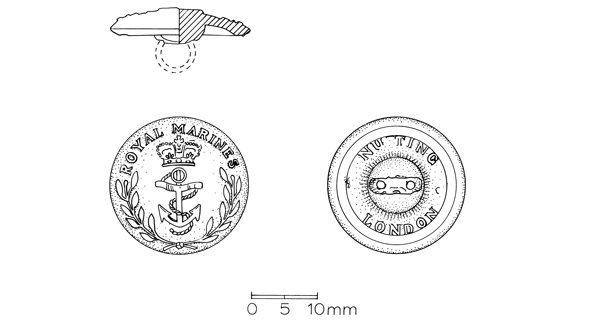
-
Where was this artifact found?
Two buttons from the uniform of a royal marine were discovered together on the lower deck, protected by an upside down plate.
-
What material is this artifact made of?
These domed pewter buttons bear a design consisting of a crowned fouled anchor (entwined with its own cable), a laurel wreath and the inscription “ROYAL MARINES.”
-
What was this artifact used for?
These two buttons are from the uniform of one of the thirteen marines from the expedition (if both buttons are indeed from the same uniform). There were five privates, one corporal and one sergeant from the Royal Marines on board HMS Erebus in 1845.
-
What do we know about this artifact?
The inscriptions “NUTTING” and “LONDON,” which is the manufacturer’s brand, is engraved on the back of the button. The Nuttings were merchants established in London between 1800 and 1865. Identical buttons, bearing the same maker marks, are housed in the Parks Canada and National Maritime Museum collections.
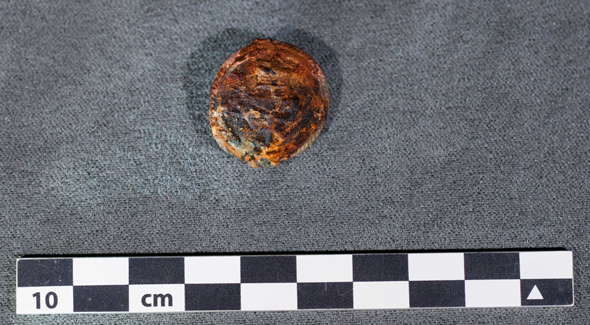
Recovered from HMS Erebus, on lower deck
September 2015
Royal Navy Officer’s Button

-
Where was this artifact found?
This Royal Navy officer’s button was found in the captain’s cabin, on the lower deck, signifying that it is from an officer’s uniform.
-
What material is this artifact made of?
This uniform button made of gilded brass bears on its obverse side a crowned fouled anchor (entwined with its own cable). The central design is circled by a raised line, with a rope along the edge. The background is embellished with thin incised parallel lines. The archaeologists noticed remnants of gold colour on the edge; according to conservation science specialists, it is gold leaf, confirming that the button belonged to the uniform of a Royal Navy officer.
-
What was this artifact used for?
The uniforms belonging to the officers on board the HMS Erebus all had buttons like this one. These were Royal Navy regulation from 1827 onward.
-
What do we know about this artifact?
The maker’s mark on this button reads “P. & S. FIRMIN 153 STRAND,” a reputable supplier to the Navy, established in London.
Royal Navy Officer’s Button
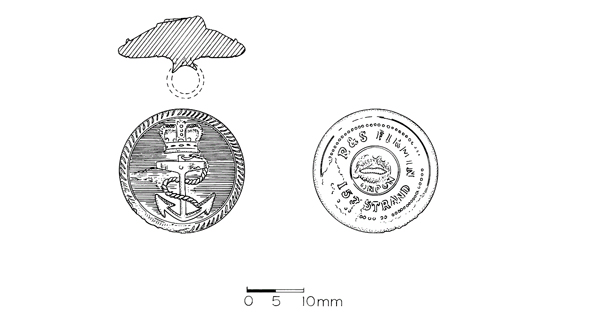
-
Where was this artifact found?
This Royal Navy officer’s button was found in the captain’s cabin, on the lower deck, signifying that it is from an officer’s uniform.
-
What material is this artifact made of?
This uniform button made of gilded brass bears on its obverse side a crowned fouled anchor (entwined with its own cable). The central design is circled by a raised line, with a rope along the edge. The background is embellished with thin incised parallel lines. The archaeologists noticed remnants of gold colour on the edge; according to conservation science specialists, it is gold leaf, confirming that the button belonged to the uniform of a Royal Navy officer.
-
What was this artifact used for?
The uniforms belonging to the officers on board the HMS Erebus all had buttons like this one. These were Royal Navy regulation from 1827 onward.
-
What do we know about this artifact?
The maker’s mark on this button reads “P. & S. FIRMIN 153 STRAND,” a reputable supplier to the Navy, established in London.
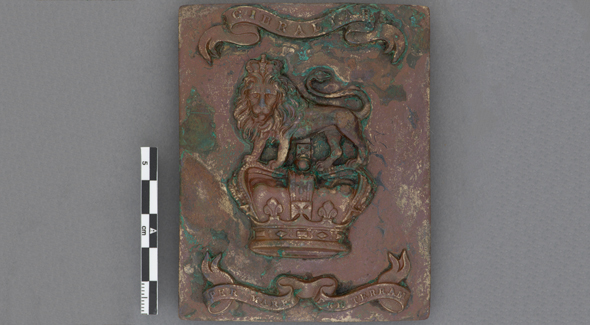
Recovered from HMS Erebus, on lower deck
September 2015
Shoulder plate

-
Where was this artifact found?
The artifact was found face down on the lower deck, near the Royal Marines’ buttons, in the forecastle.
-
What material is this artifact made of?
This rectangular brass shoulder belt plate bears the design of a crowned lion, and two banners. The upper banner marked “GIBRALTAR” refers to the first battle honour of the Royal Marines in 1704. The lower banner bears the inscription “PER MARE, PER TERRAM,” which is the Corps’ motto, meaning “by sea, by land.”
-
What was this artifact used for?
Based on historical and archaeological evidence this painting depicts how the shoulder belt plate would have been worn on a Royal Marines sergeant dress uniform.
-
What do we know about this artifact?
According to its design and quality, the shoulder belt plate most probably belonged to one of the two sergeants of the expedition, logically Daniel Bryant of HMS Erebus (or Soloman Tozer of HMS Terror).
Shoulder plate
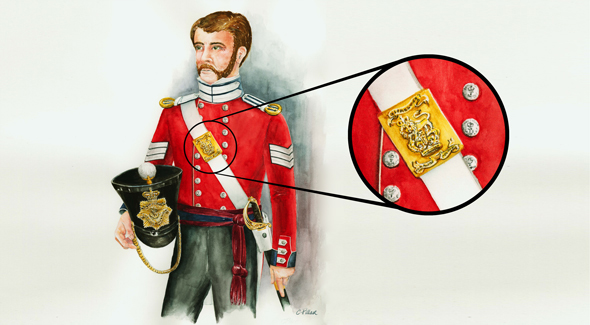
-
Where was this artifact found?
The artifact was found face down on the lower deck, near the Royal Marines’ buttons, in the forecastle.
-
What material is this artifact made of?
This rectangular brass shoulder belt plate bears the design of a crowned lion, and two banners. The upper banner marked “GIBRALTAR” refers to the first battle honour of the Royal Marines in 1704. The lower banner bears the inscription “PER MARE, PER TERRAM,” which is the Corps’ motto, meaning “by sea, by land.”
-
What was this artifact used for?
Based on historical and archaeological evidence this painting depicts how the shoulder belt plate would have been worn on a Royal Marines sergeant dress uniform.
-
What do we know about this artifact?
According to its design and quality, the shoulder belt plate most probably belonged to one of the two sergeants of the expedition, logically Daniel Bryant of HMS Erebus (or Soloman Tozer of HMS Terror).
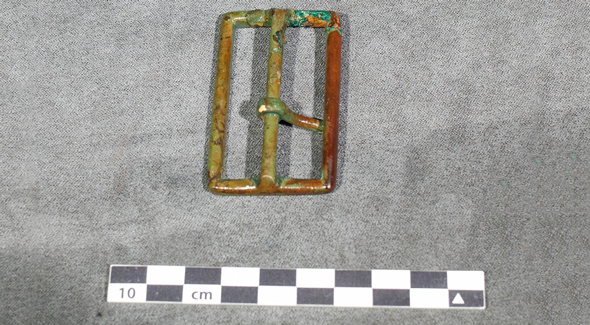
Recovered from HMS Erebus, on lower deck
September 2015
Belt buckle

-
Where was this artifact found?
The belt buckle was found on the port side of the lower deck, in the forecastle.
-
What material is this artifact made of?
The artifact is made of welded brass wire 1 cm in diameter.
-
What was this artifact used for?
This type of buckle was generally used on a belt around the waist or to adjust a bag’s strap.
-
What do we know about this artifact?
It could have been part of a seaman’s or royal marines’ equipment. It could also be linked to other items from the royal marines’ uniform found nearby.
Belt buckle
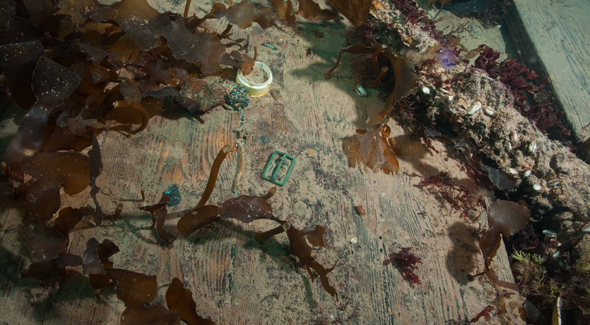
-
Where was this artifact found?
The belt buckle was found on the port side of the lower deck, in the forecastle.
-
What material is this artifact made of?
The artifact is made of welded brass wire 1 cm in diameter.
-
What was this artifact used for?
This type of buckle was generally used on a belt around the waist or to adjust a bag’s strap.
-
What do we know about this artifact?
It could have been part of a seaman’s or royal marines’ equipment. It could also be linked to other items from the royal marines’ uniform found nearby.
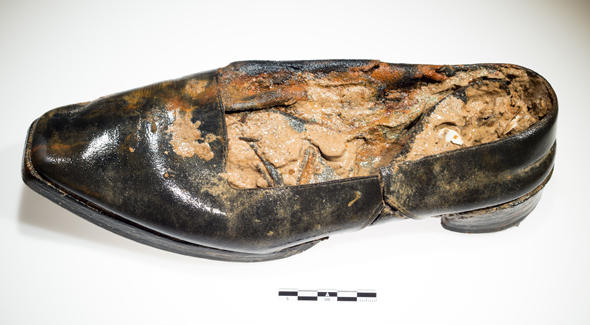
Recovered from HMS Erebus, on lower deck
September 2015
Boot

-
Where was this artifact found?
This boot was found in an officer’s cabin on the port side of the lower deck.
-
What material is this artifact made of?
This quality leather winter boot was custom made for one of the officers on board. It is a left boot. The body, made of patent leather, was completed by what appears to be a wool gaiter. By analyzing its content, researchers discovered that it was lined with wool felt and decorated or lined with seal fur.
-
What was this artifact used for?
This officer’s boot was designed to keep its owner’s feet warm despite the cold Arctic temperatures. It is narrow and has a squared tip, however, indicating that it was also designed to be in line with the fashion of the times.
-
What do we know about this artifact?
Small samples of the sole were collected and sent for human DNA extraction and sequencing. The DNA profile that was extracted was compared with existing data on the Franklin expedition to identify its owner, without any success thus far.
Boot

-
Where was this artifact found?
This boot was found in an officer’s cabin on the port side of the lower deck.
-
What material is this artifact made of?
This quality leather winter boot was custom made for one of the officers on board. It is a left boot. The body, made of patent leather, was completed by what appears to be a wool gaiter. By analyzing its content, researchers discovered that it was lined with wool felt and decorated or lined with seal fur.
-
What was this artifact used for?
This officer’s boot was designed to keep its owner’s feet warm despite the cold Arctic temperatures. It is narrow and has a squared tip, however, indicating that it was also designed to be in line with the fashion of the times.
-
What do we know about this artifact?
Small samples of the sole were collected and sent for human DNA extraction and sequencing. The DNA profile that was extracted was compared with existing data on the Franklin expedition to identify its owner, without any success thus far.
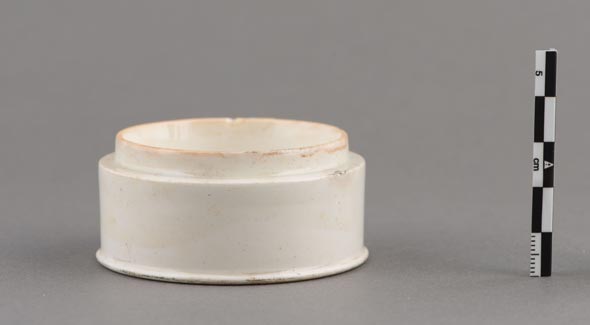
Recovered from HMS Erebus, on lower deck
September 2015
Ointment pot

-
Where was this artifact found?
The ointment pot was found near 40 percussion caps on the lower deck, in the forecastle.
-
What material is this artifact made of?
This ointment pot is made of whiteware. It bears the inscription “1 oz” on its base.
-
What was this artifact used for?
This common type of pot was used to store various products, usually shaving cream, shoe polish and face cream. The pots sometimes contained condiments such as anchovy paste. Ointment pot lids were usually decorated with labels aimed at promoting the product and its manufacturer. However, no lid has been found with this artifact.
-
What do we know about this artifact?
When it was discovered, the pot contained a substance, which was later identified as a natural deposit. No trace of its original content was detected.
Ointment pot
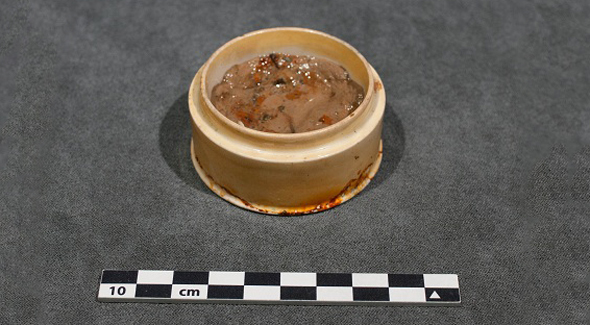
-
Where was this artifact found?
The ointment pot was found near 40 percussion caps on the lower deck, in the forecastle.
-
What material is this artifact made of?
This ointment pot is made of whiteware. It bears the inscription “1 oz” on its base.
-
What was this artifact used for?
This common type of pot was used to store various products, usually shaving cream, shoe polish and face cream. The pots sometimes contained condiments such as anchovy paste. Ointment pot lids were usually decorated with labels aimed at promoting the product and its manufacturer. However, no lid has been found with this artifact.
-
What do we know about this artifact?
When it was discovered, the pot contained a substance, which was later identified as a natural deposit. No trace of its original content was detected.
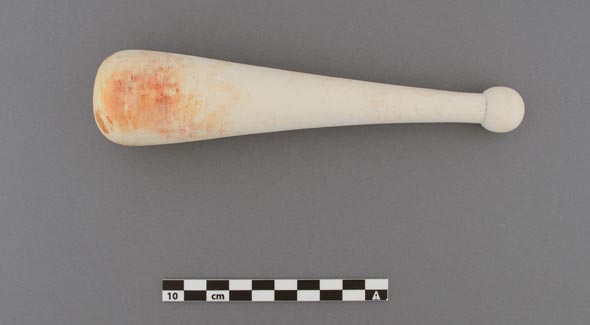
Recovered from HMS Erebus, on lower deck
September 2015
Pestle

-
Where was this artifact found?
The pestle was found in the area of the officers’ cabins, on the port side of the lower deck.
-
What material is this artifact made of?
This ceramic pestle measuring 18.5 cm in length is oval shaped at one end and is in the shape of a small ball at the other end.
-
What was this artifact used for?
This artifact, designed to crush substances, was a standard item in any collection of medicinal tools; however, it could have been used for other purposes, particularly in the preparation of food and paint pigments.
-
What do we know about this artifact?
The pestle was analyzed to detect traces of the last substance it crushed, without any success. The artifact bears the number “2,” which suggests that it was part of a set with varying sizes.
Pestle
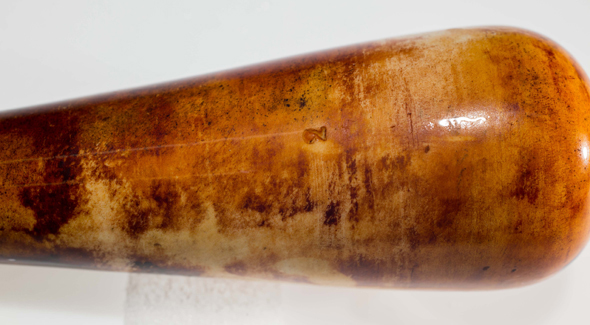
-
Where was this artifact found?
The pestle was found in the area of the officers’ cabins, on the port side of the lower deck.
-
What material is this artifact made of?
This ceramic pestle measuring 18.5 cm in length is oval shaped at one end and is in the shape of a small ball at the other end.
-
What was this artifact used for?
This artifact, designed to crush substances, was a standard item in any collection of medicinal tools; however, it could have been used for other purposes, particularly in the preparation of food and paint pigments.
-
What do we know about this artifact?
The pestle was analyzed to detect traces of the last substance it crushed, without any success. The artifact bears the number “2,” which suggests that it was part of a set with varying sizes.
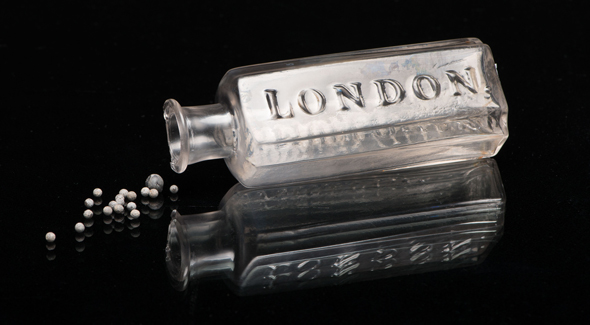
Recovered from HMS Erebus, on lower deck
April 2015
Pharmaceutical bottle

-
Where was this artifact found?
This bottle was found on the lower deck, on the port side of the forecastle.
-
What material is this artifact made of?
This small octagonal medicine bottle is made of colourless glass. It bears the inscriptions “Samuel Oxley” and “London.”
-
What was this artifact used for?
Oxley was a London chemist who sold a “concentrated essence of Jamaican ginger root,” a compound that was said to heal a variety of ailments, from digestive problems to hypochondria. On board the ship, this substance could have been used as a popular treatment for seasickness. However, the analysis of this bottle’s contents revealed traces of gum arabic and potassium bicarbonate. It also contained 19 lead shots (one buck-shot and 18 bird shots).
-
What do we know about this artifact?
It is believed that this bottle could have been purchased for its original content, Oxley’s essence of ginger root, perhaps some years before the 1845 expedition. The bottle was reused later on to store gum arabic and potassium bicarbonate. The bottle was finally used to store small lead shots.
Pharmaceutical bottle
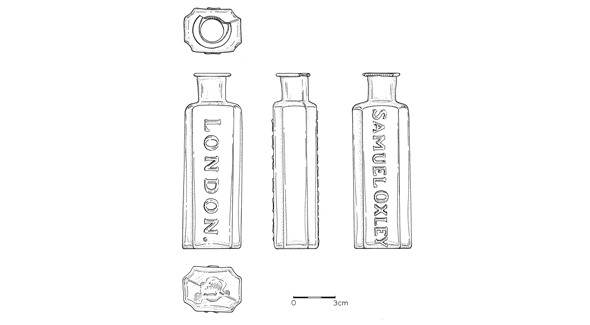
-
Where was this artifact found?
This bottle was found on the lower deck, on the port side of the forecastle.
-
What material is this artifact made of?
This small octagonal medicine bottle is made of colourless glass. It bears the inscriptions “Samuel Oxley” and “London.”
-
What was this artifact used for?
Oxley was a London chemist who sold a “concentrated essence of Jamaican ginger root,” a compound that was said to heal a variety of ailments, from digestive problems to hypochondria. On board the ship, this substance could have been used as a popular treatment for seasickness. However, the analysis of this bottle’s contents revealed traces of gum arabic and potassium bicarbonate. It also contained 19 lead shots (one buck-shot and 18 bird shots).
-
What do we know about this artifact?
It is believed that this bottle could have been purchased for its original content, Oxley’s essence of ginger root, perhaps some years before the 1845 expedition. The bottle was reused later on to store gum arabic and potassium bicarbonate. The bottle was finally used to store small lead shots.
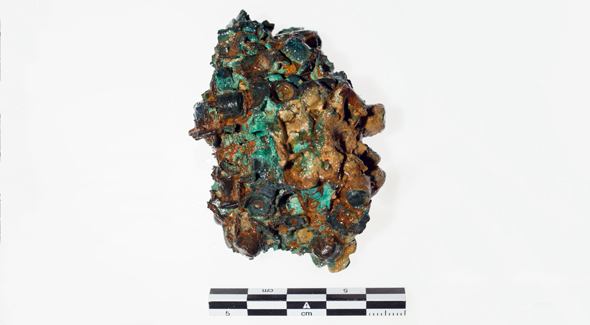
Recovered from HMS Erebus, on lower deck
September 2015
40 Percussion caps

-
Where was this artifact found?
The percussion caps were found corroded together on the lower deck of HMS Erebus.
-
What material is this artifact made of?
The percussion caps are small copper alloy cylinders that are closed at one end. They contained an explosive charge usually composed of fulminate of mercury, potassium chlorate and glass powder.
-
What was this artifact used for?
Percussion muskets had just been introduced to the Royal Navy when HMS Erebus weighed anchor in 1845. The caps contain a small explosive charge that ignites when the musket’s trigger is pulled and the firing pin strikes the cap. Numerous percussion caps from the Franklin Expedition were previously found at various sites on King William Island.
-
What do we know about this artifact?
X-ray imagery helped determine that the 40 individual caps that are corroded and bound together had not been used. The caps were probably stored in a bag that has long since decomposed.
40 Percussion caps
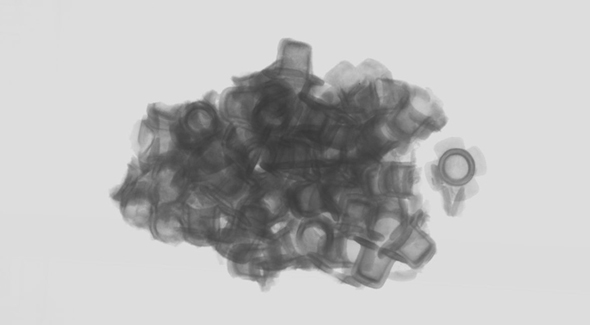
-
Where was this artifact found?
The percussion caps were found corroded together on the lower deck of HMS Erebus.
-
What material is this artifact made of?
The percussion caps are small copper alloy cylinders that are closed at one end. They contained an explosive charge usually composed of fulminate of mercury, potassium chlorate and glass powder.
-
What was this artifact used for?
Percussion muskets had just been introduced to the Royal Navy when HMS Erebus weighed anchor in 1845. The caps contain a small explosive charge that ignites when the musket’s trigger is pulled and the firing pin strikes the cap. Numerous percussion caps from the Franklin Expedition were previously found at various sites on King William Island.
-
What do we know about this artifact?
X-ray imagery helped determine that the 40 individual caps that are corroded and bound together had not been used. The caps were probably stored in a bag that has long since decomposed.
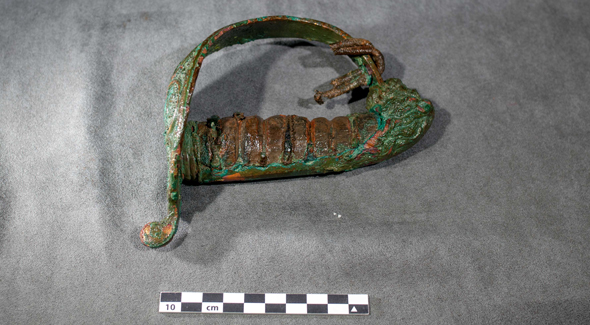
Recovered from HMS Erebus, on lower deck
September 2015
Sword hilt

-
Where was this artifact found?
This 1827 model naval sword hilt was found near or in one of the officers’ cabins.
-
What material is this artifact made of?
This sword has a lavishly designed gilded brass guard. The pommel is in the shape of a lion’s head. The wooden grip is covered with shark skin bound with gold-plated copper wires. The guard is decorated with a typical crown and fouled anchor badge.
-
What was this artifact used for?
This specific sword hilt model was used by all British Royal Navy officers from 1827 onward. The model is still used in ceremonies today.
-
What do we know about this artifact?
The detailed analysis of the sword knot fragment still attached to the artifact when it was discovered made it possible to determine its composition. The strands are made of silk with gold-plated silver threads woven in and braided to form a sword knot in silver and blue - the regulation colours of the Royal Navy.
Sword hilt
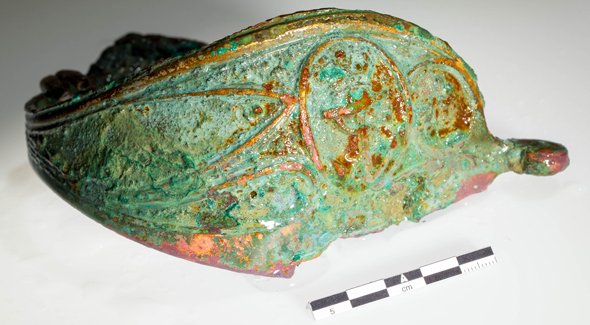
-
Where was this artifact found?
This 1827 model naval sword hilt was found near or in one of the officers’ cabins.
-
What material is this artifact made of?
This sword has a lavishly designed gilded brass guard. The pommel is in the shape of a lion’s head. The wooden grip is covered with shark skin bound with gold-plated copper wires. The guard is decorated with a typical crown and fouled anchor badge.
-
What was this artifact used for?
This specific sword hilt model was used by all British Royal Navy officers from 1827 onward. The model is still used in ceremonies today.
-
What do we know about this artifact?
The detailed analysis of the sword knot fragment still attached to the artifact when it was discovered made it possible to determine its composition. The strands are made of silk with gold-plated silver threads woven in and braided to form a sword knot in silver and blue - the regulation colours of the Royal Navy.
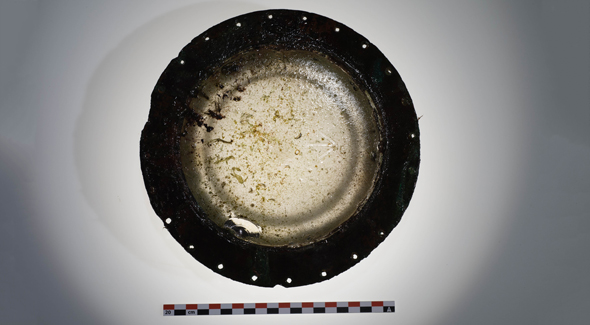
Recovered from HMS Erebus, on lower deck
April 2015
Preston patent illuminator

-
Where was this artifact found?
The illuminator was found in the forecastle, on the port side of the lower deck. It must have detached from the upper deck that was once above this location.
-
What material is this artifact made of?
The Preston illuminator, with a round glass prism also called a “bull’s eye,” was encased in a brass frame, and then sealed with a linseed oil and lead compound.
-
What was this artifact used for?
There were two different styles of illuminators installed in the upper deck of both HMS Erebus and HMS Terror to distribute natural light below. The 1839 plans indicate that the ships were both equipped with 11 rectangular prisms and 30 of the more recent, round illuminators (Preston patent).
-
What do we know about this artifact?
Prior to his Antarctic expedition (1839-1843), Captain James Clark Ross ordered Preston illuminators for HMS Erebus and HMS Terror. He had recognized their value during previous Arctic expeditions, given the ability to replace the glass with an air vent to improve air circulation below deck and thus reduce the amount of “stale air and unpleasant fumes.” However, the illuminator found on HMS Erebus does not have this feature.
Preston patent illuminator
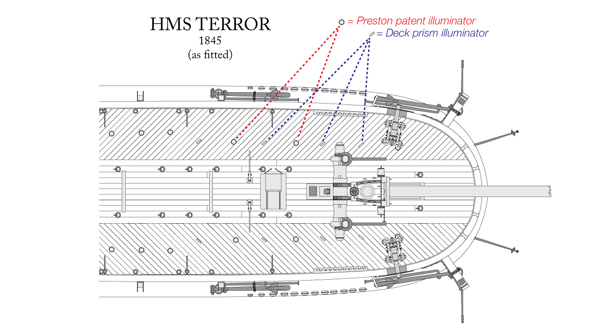
© Building HMS Terror
-
Where was this artifact found?
The illuminator was found in the forecastle, on the port side of the lower deck. It must have detached from the upper deck that was once above this location.
-
What material is this artifact made of?
The Preston illuminator, with a round glass prism also called a “bull’s eye,” was encased in a brass frame, and then sealed with a linseed oil and lead compound.
-
What was this artifact used for?
There were two different styles of illuminators installed in the upper deck of both HMS Erebus and HMS Terror to distribute natural light below. The 1839 plans indicate that the ships were both equipped with 11 rectangular prisms and 30 of the more recent, round illuminators (Preston patent).
-
What do we know about this artifact?
Prior to his Antarctic expedition (1839-1843), Captain James Clark Ross ordered Preston illuminators for HMS Erebus and HMS Terror. He had recognized their value during previous Arctic expeditions, given the ability to replace the glass with an air vent to improve air circulation below deck and thus reduce the amount of “stale air and unpleasant fumes.” However, the illuminator found on HMS Erebus does not have this feature.
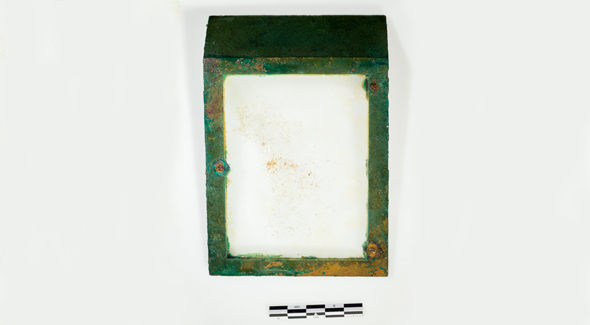
Recovered from HMS Erebus, on lower deck
April 2015
Artificial horizon roof

-
Where was this artifact found?
This artificial horizon roof was found in the area of an officer’s cabin on the port side of the lower deck.
-
What material is this artifact made of?
The part of the artificial horizon that was found is a brass frame fitted with a glass pane.
-
What was this artifact used for?
Mercurial artificial horizons were used with sextants to determine the latitude when the horizon was not visible, due to poor visibility or when obstacles such as ice obscured the horizon. This roof was used to cover a mercury-filled tray that actually created the artificial horizon.
-
What do we know about this artifact?
Because of a storm in September 2015, only part of the artifact could be recovered. At this time, it is impossible to determine the manufacturing date or the name of its manufacturer. It is possible that the other parts of the artifact bear a marking.
Artificial horizon roof
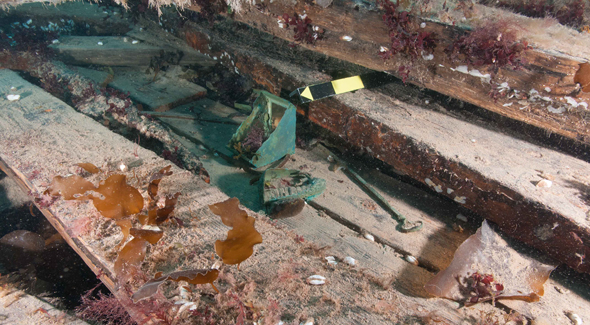
-
Where was this artifact found?
This artificial horizon roof was found in the area of an officer’s cabin on the port side of the lower deck.
-
What material is this artifact made of?
The part of the artificial horizon that was found is a brass frame fitted with a glass pane.
-
What was this artifact used for?
Mercurial artificial horizons were used with sextants to determine the latitude when the horizon was not visible, due to poor visibility or when obstacles such as ice obscured the horizon. This roof was used to cover a mercury-filled tray that actually created the artificial horizon.
-
What do we know about this artifact?
Because of a storm in September 2015, only part of the artifact could be recovered. At this time, it is impossible to determine the manufacturing date or the name of its manufacturer. It is possible that the other parts of the artifact bear a marking.
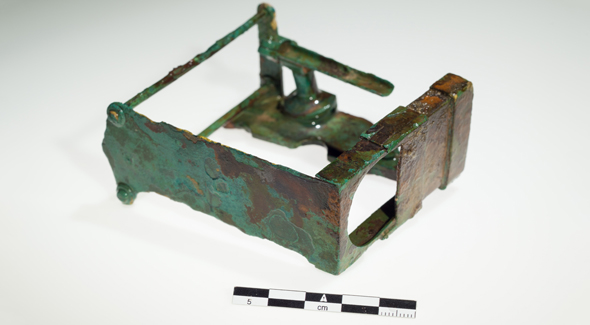
Recovered from HMS Erebus, on lower deck
April 2015
Scientific instrument

-
Where was this artifact found?
The frame of a scientific instrument was found on the lower deck in the captain’s cabin at the stern of HMS Erebus.
-
What material is this artifact made of?
The artifact is made of brass wires welded to brass sheets to form a frame.
-
What do we know about this artifact?
Given its sophisticated design and final location, it is believed that it could be part of a scientific instrument. Research is currently being done to identify the artifact with certainty.
Scientific instrument
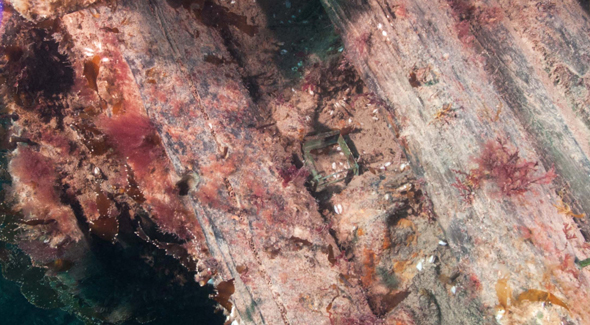
-
Where was this artifact found?
The frame of a scientific instrument was found on the lower deck in the captain’s cabin at the stern of HMS Erebus.
-
What material is this artifact made of?
The artifact is made of brass wires welded to brass sheets to form a frame.
-
What do we know about this artifact?
Given its sophisticated design and final location, it is believed that it could be part of a scientific instrument. Research is currently being done to identify the artifact with certainty.
Scientific instrument

-
Where was this artifact found?
The frame of a scientific instrument was found on the lower deck in the captain’s cabin at the stern of HMS Erebus.
-
What material is this artifact made of?
The artifact is made of brass wires welded to brass sheets to form a frame.
-
What do we know about this artifact?
Given its sophisticated design and final location, it is believed that it could be part of a scientific instrument. Research is currently being done to identify the artifact with certainty.
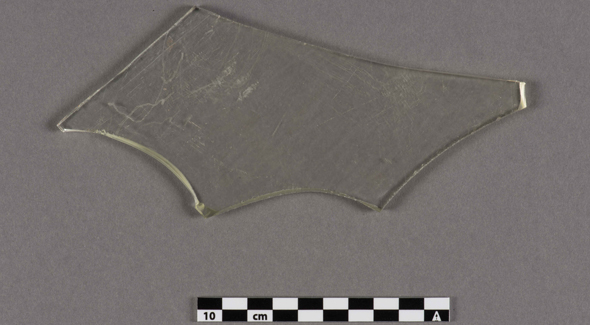
Recovered from HMS Erebus, on lower deck
September 2015
Window glass

-
Where was this artifact found?
This fragment of window glass was found on the lower deck at the aft end of the captain’s cabin.
-
What material is this artifact made of?
The artifact is made of colourless glass.
-
What was this artifact used for?
This glass possibly belonged to a window pane from the stern-gallery, or from the skylights over the captain’s cabin and the officers’ mess.
-
What do we know about this artifact?
One of the edges of the glass is smooth and free of scratches, indicating that it was the edge of a fixed window.
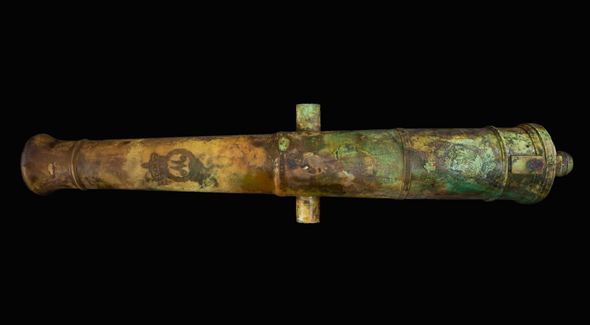
Recovered from HMS Erebus, in debris field
April 2015
Cannon

-
Where was this artifact found?
The cannon was found in the debris field at the stern of the wreck, on the seabed.
-
What material is this artifact made of?
This cannon was cast in bronze. It contained three shots, but no explosive charge.
-
What was this artifact used for?
This cannon is called a “six-pounder” because it fired six-pound shot. The British military used this type of weapon on both land and sea. The cannon was cast in 1812 by John and Henry King at the Royal Brass Foundry at Woolwich, England.
-
What do we know about this artifact?
There are several inscriptions on the barrel of this cannon. The letters “GR” encircled by the motto “Honi soit qui mal y pense” and topped by a crown is the cypher of King George III. This cannon also bears the name of the master founder, the coat of arms of the Master General of the Ordnance (the Earl of Musgrave), and a serial number.
Cannon

-
Where was this artifact found?
The cannon was found in the debris field at the stern of the wreck, on the seabed.
-
What material is this artifact made of?
This cannon was cast in bronze. It contained three shots, but no explosive charge.
-
What was this artifact used for?
This cannon is called a “six-pounder” because it fired six-pound shot. The British military used this type of weapon on both land and sea. The cannon was cast in 1812 by John and Henry King at the Royal Brass Foundry at Woolwich, England.
-
What do we know about this artifact?
There are several inscriptions on the barrel of this cannon. The letters “GR” encircled by the motto “Honi soit qui mal y pense” and topped by a crown is the cypher of King George III. This cannon also bears the name of the master founder, the coat of arms of the Master General of the Ordnance (the Earl of Musgrave), and a serial number.
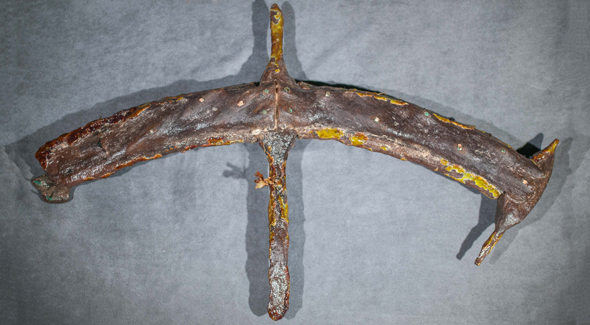
Recovered from HMS Erebus, in debris field
September 2015
Ship's wheel

-
Where was this artifact found?
This fragment of the ship’s wheel (helm) was found on the seabed some distance south of the bow of the wreck. The wheel of HMS Erebus was originally installed on the upper deck at the ship’s stern.
-
What material is this artifact made of?
The wheel of HMS Erebus comprised several mahogany parts assembled with copper alloy nails.
-
What was this artifact used for?
The artifact served to operate the ship’s steering mechanism. Remarkably, the double-wheeled helm of HMS Terror is practically intact on the upper deck of the wreck. The wheel of HMS Erebus was probably very similar in shape and size.
-
What do we know about this artifact?
According to its diameter, which is estimated to have been 120 cm, this wheel had 10 spokes. The artifact represents approximately 20% of the original wheel. This very wheel can be seen in a daguerreotype of Lieutenant Henry LeVesconte on board HMS Erebus prior to the departure of the 1845 expedition.
Ship's wheel
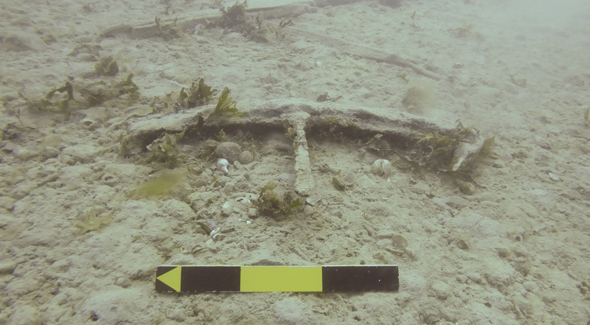
-
Where was this artifact found?
This fragment of the ship’s wheel (helm) was found on the seabed some distance south of the bow of the wreck. The wheel of HMS Erebus was originally installed on the upper deck at the ship’s stern.
-
What material is this artifact made of?
The wheel of HMS Erebus comprised several mahogany parts assembled with copper alloy nails.
-
What was this artifact used for?
The artifact served to operate the ship’s steering mechanism. Remarkably, the double-wheeled helm of HMS Terror is practically intact on the upper deck of the wreck. The wheel of HMS Erebus was probably very similar in shape and size.
-
What do we know about this artifact?
According to its diameter, which is estimated to have been 120 cm, this wheel had 10 spokes. The artifact represents approximately 20% of the original wheel. This very wheel can be seen in a daguerreotype of Lieutenant Henry LeVesconte on board HMS Erebus prior to the departure of the 1845 expedition.
Other galleries
- Date modified :
